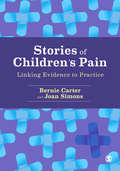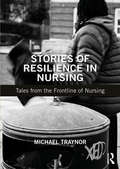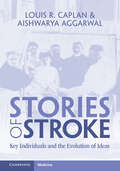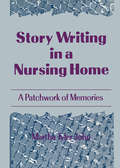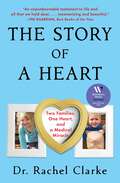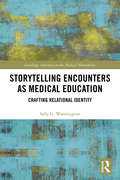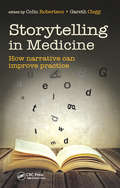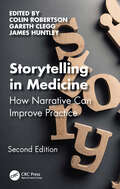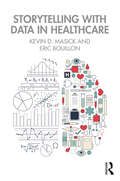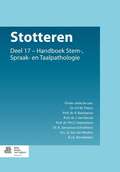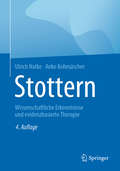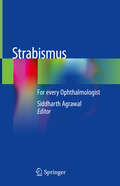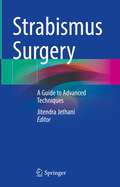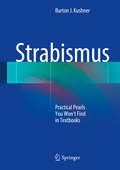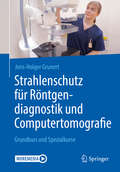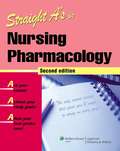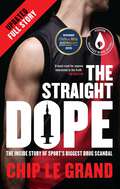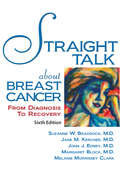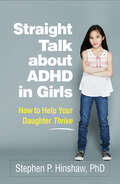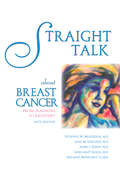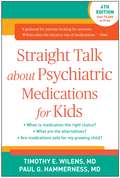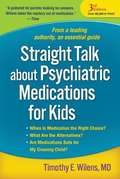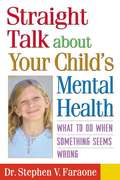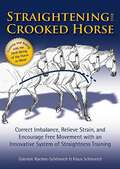- Table View
- List View
Stories of Children's Pain: Linking Evidence to Practice
by Bernie Carter Ms Joan SimonsWorking with a child in pain is difficult, unavoidable and especially challenging when the child cannot explain what they are feeling. In this important book, Bernie Carter and Joan Simons bring together experience, evidence and research to deconstruct the topic and present the reality of children's pain. Each chapter starts with a personal story from a child, a family member or a healthcare professional. The stories are drawn from a wealth of original research, and focus the reader on the individual child and their family. The chapter then goes on to introduce the relevant research, theory and implications for practice, so health professionals can use the evidence to support compassionate, child-centred care. Among the topics addressed are: - Ethical dilemmas - Assessing pain - Working in different settings - Inexplicable pain It is valuable reading for any healthcare student or professional working with children of all ages.
Stories of Resilience in Nursing: Tales from the Frontline of Nursing
by Michael TraynorIdeas about resilience and identity continue to be promoted, discussed and debated in nursing. This book uses narratives to explore these complex and important concepts, unsettling our certainties and opening up new perspectives on what they might mean and involve. This engaging book recounts direct and vivid stories told by or about nurses. These vignettes discuss nursing’s ideals without idealising them and show nursing work and the lives of nurses in all their complexity. They include contributions from mental health nurses, a former nurse, student nurses, a migrant nurse and a whistle-blowing nurse, among others. The book ends with chapter-by-chapter contextual material to promote reflection, discussion and further reading. Written with nursing students preparing to transition to the workplace and professional status in mind, this thought-provoking book is also suitable for nurses and nurse academics interested in resilience and issues around professional identity.
Stories of Stroke: Key Individuals and the Evolution of Ideas
by Louis R. Caplan Aishwarya AggarwalStroke is one of the most important and most feared conditions known to man. The threat of stroke is important to all people. What could be more devastating than to lose the ability to speak, move a limb, stand, talk, see, read, feel write or even think? This book brings together ideas, events and advances – the stories – before and during the 20th Century through the accounts of global experts in the field, many of them having been first-hand witnesses to progress. Focusing on selected stories of stroke, this book offers a readable summary of the most dramatic and extensive changes in knowledge about stroke and in caring for stroke patients. Of interest to anyone interested in neurosciences and for physicians caring for stroke patients, this book informs on moving forward, by looking to how we got to where we are.
Story Writing in a Nursing Home: A Patchwork of Memories
by Martha A JohnBased on the belief that older people have good stories to tell, Story Writing in a Nursing Home was developed as part of a volunteer teaching service to a nursing home. Graduate students who were learning to teach this special population conducted story writing activities with older adults and found that even the frail elderly who are confined to nursing centers provided a unique perspective about events that emphasize the lasting verities in life. The idea of a patchwork was derived from one of the lessons taught and was suggested by one of the older participants who said, “We’re sort of like a patchwork quilt.” The information, memories, and humor the elderly see in situations is worth recording. In addition, Story Writing in a Nursing Home emphasizes the way to develop the mental stimulation that is so important for physical well being. This sensitive and insightful book provides a lesson plan outline and the type of content that was used as an example. It also provides a running commentary in the form of a diary that tells how to begin a teaching program for nursing center residents. Students and professionals interested in implementing a similar program can use these ideas for planning and for organizing the use of student help to better serve the population. Fascinating reading, this book includes stories by frail elderly people, lesson plans, tips on working with administrators in a nursing center, and reasons for providing instruction. Teachers, volunteers, librarians, gerontology/sociology students, and others concerned with the well-being of the elderly will refer often to this instructive volume.
Story of a Heart: Two Families, One Heart, and the Medical Miracle that Saved a Child's Life
by Rachel ClarkeA riveting and inspiring true story of two families linked by one heart—written by a bestselling author and palliative care doctor. The first of our organs to form and the last to die, the heart is both a simple pump and the symbol of what makes us human; as long as it continues to beat, there is hope. In The Story of a Heart, Dr. Rachel Clarke interweaves the history of medical innovations behind transplant surgery with the story of two children—one of whom desperately needs a new heart. One summer day, nine-year-old Keira Ball was in a terrible car accident and suffered catastrophic brain injuries. As the rest of her body began to shut down, her heart continued to beat. In an act of extraordinary generosity, Keira&’s parents and siblings immediately agreed that she would have wanted to be an organ donor. Meanwhile nine-year-old Max Johnson had been in a hospital for nearly a year, valiantly fighting the virus that was causing his young heart to fail. When Max&’s parents received the call they had been hoping for, they knew it came at a terrible cost to another family—in what Clarke calls &“the brutal arithmetic of transplant surgery.&” The act of Keira&’s heart resuming its rhythm inside Max&’s body was a medical miracle. But this was only part of the story. While waiting on the transplant list, Max had become the hopeful face of a campaign to change the UK&’s laws around organ donation. Following his successful surgery, Keira&’s mother saw the little boy beaming on the front page of the newspaper and knew it was the same boy whose parents had recently sent her an anonymous letter overflowing with gratitude for her daughter&’s heart. The two mothers began to exchange messages and eventually decided to meet. This is the unforgettable story of how one family&’s grief transformed into a lifesaving gift. Clarke relates the urgent journey of Keira&’s heart and explores the history of the remarkable surgery that made it possible, stretching back over a century and involving the knowledge and dedication not just of surgeons but of countless nurses and technicians, immunologists and paramedics. The Story of a Heart is a testament to compassion for the dying, the many ways we honor our loved ones, and the tenacity of love.
Storytelling Encounters as Medical Education: Crafting Relational Identity (Routledge Advances in the Medical Humanities)
by Sally G. WarmingtonThis innovative volume provides fresh perspectives on how medical students and patients construct identities in relation to each other, using stories of their clinical encounters. It explores how paying attention to medical students’ and patients’ stories in clinical teaching encounters can encourage empathy and the formation of professional identities that embody desirable values such as integrity and respect. Written by an experienced clinician and based on original, rigorous research combining ethnography and dialogic narrative analysis, Storytelling Encounters as Medical Education: Crafting Relational Identity includes patient stories alongside those of students and clinical teachers. This is an important contribution for all those interested in medical education, narrative medicine, person-centred care and identity formation in healthcare. It will also be of value to scholars in a range of other disciplines, who are using a dialogic approach.
Storytelling in Medicine: How Narrative can Improve Practice
by Colin Robertson & Gareth CleggThroughout our lives, story is the medium each of us uses to make sense of our environment and relationships. Stories provide meaning and context, enriching our experiences and equipping us with a framework to navigate our existence. Storytelling in Medicine is aunique, practical book for healthcare trainees, practitioners and educators that explores the ideas and practice of narrative and storytelling that lie at the very heart of clinical medicine and the patient ‘experience’ of care. It shows how story and narrative can be used effectively to help convey concepts such as prognosis and the effect of illness upon life, and to prepare patients and their relatives for difficult and painful news. Offering a particular insight into communication by and between healthcare professionals, and how it can be refocused and improved, the book is an invaluable teaching aid for educators working in both small and large formats, and for under- and postgraduate students.
Storytelling in Medicine: How narrative can improve practice
by Colin Robertson, Gareth Clegg, James HuntleyThroughout our lives, story is the medium each of us uses to make sense of our environment and relationships. Stories provide meaning and context, enriching our experiences and equipping us with a framework to navigate our existence. This unique, practical book for healthcare trainees, practitioners and educators explores the ideas and practice of narrative and storytelling that lie at the very heart of clinical medicine and the patient ‘experience’ of care. It shows how story and narrative can be used effectively to help convey concepts such as prognosis and the effect of illness upon life, and to prepare patients and their relatives for difficult and painful news. Offering a particular insight into communication by and between healthcare professionals, and how it can be refocused and improved, this updated and expanded second edition remains an invaluable teaching aid for educators working in both small and large formats, and for under- and postgraduate students.
Storytelling with Data in Healthcare
by Kevin Masick Eric BouillonWith the constant evolution of change in healthcare from both a technology and governmental perspective, it is imperative to take a step back and view the big picture. Relying on hunches or beliefs is no longer sustainable, so avoid jumping to conclusions and making decisions without thoroughly understanding the statistics being analyzed. The triple aim of statistics is a conceptual model laying the foundation for improving healthcare outcomes through statistics. This foundation is: know your numbers; develop behavioral interventions; and set goals to drive change.With the availability of electronic data sources, the quantity and quality of data have grown exponentially to the point of information overload. Translating all this data into words that tell a meaningful story is overwhelming. This book takes the reader on a journey that navigates through this data to tell a story that everyone can understand and use to drive improvement. Readers will learn to tell a narrative story based on data, to develop creative, innovative and effective solutions to improve processes and outcomes utilizing the authors’ tools. Topics include mortality and readmission, patient experience, patient safety survey, governmental initiatives, CMS Star Rating and Hospital Compare.Storytelling with Data in Healthcare combines methodology and statistics in the same course material, making it coherent and easier to put into practice. It uses storytelling as a tool for knowledge acquisition and retention and will be valuable for courses in nursing schools, medical schools, pharmacy schools or any healthcare profession that has a research design or statistics course offered to students. The book will be of interest to researchers, academics, healthcare professionals, and students in the fields of healthcare management and operations as well as statistics and data visualization.
Stotteren: Deel 17 - Handboek Stem-, Spraak- en Taalpathologie
by H.F.M Peters R. Bastiaanse J. Borsel P.H.O. Dejonckere K. Jansonius-Schultheiss Sj. Meulen B.J.E. MondelaersHet Handboek Stem-Spraak-Taalpathologie verscheen tussen 1997 en 2007 gefaseerd in losse afleveringen. Daarin werd alle kennis op het gebied van de stem-, spraak- en taalpathologie vanuit verschillende disciplines samengebracht. Het Handboek is bestemd voor iedereen die klinisch-praktisch of meer theoretisch is geïnteresseerd, of vanuit een ander vakgebied hiermee in aanraking komt. Voor logopedisten, artsen, linguïsten, spraak- en taalpathologen, audiologen, pedagogen en psychologen in Nederland en België is het Handboek een onmisbare vraagbaak.Deel 17 is geheel gewijd aan stotteren.
Stottern: Wissenschaftliche Erkenntnisse und evidenzbasierte Therapie
by Ulrich Natke Anke KohmäscherIn diesem Buch erhalten Sie einen Überblick über den wissenschaftlichen Stand und die aktuellen Behandlungsmethoden der Redeflussstörung Stottern. Die Häufigkeit von Stottern, Erscheinungsformen, Theorien zu den Ursachen, Diagnostik sowie Möglichkeiten der Therapie bei Kindern und Erwachsenen werden nachvollziehbar, praxisnah und auf dem neuesten Stand der Forschung dargestellt: Sprach- und Sprechstörungen, Epidemiologie und Phänomenologie, Entwicklungsverlauf und Variabilität, Ätiologie, Pathophysiologie, Diagnostik und TherapiemethodenDie Autoren engagieren sich in Lehre und Forschung und ermöglichen einen rationalen Zugang zu der verbreiteten Störung. Umfangreiche Literaturangaben ermöglichen eine vertiefende Lektüre in der Ausbildung und im Studium.Neu in der 4. Auflage: Komplett überarbeitet, aktualisiert und erweitert um folgende Themen: Mehrsprachigkeit, Exekutivfunktionen und Auswirkungen im Lebensverlauf stotternder Menschen. Das Buch ist für angehende wie für erfahrene Logopäden und Sprachtherapeuten unverzichtbar, die stotternde Menschen behandeln, und für Psychologen, Psychotherapeuten und Ärzte ein wertvolles Nachschlagewerk.
Strabismus
by Siddharth AgrawalThis book simplifies the complex subject of strabismus for postgraduate students of ophthalmology. It clarifies the basic concepts and includes clinical tips, illustrations, flow charts as well as multiple-choice questions to aid understanding. It also provides essential information that students require for examinations. Further, it encourages ophthalmologists who do not usually deal with strabismus patients to identify and manage uncomplicated cases. It discusses various management options, including the guidelines for refraction and spectacle prescription, which are often neglected. Separate chapters on surgical planning, horizontal muscle surgery and complications make strabismus surgery a reality for all eye surgeons. Lastly, the book addresses practical issues like parent counseling and alternatives to surgery.
Strabismus Surgery: A Guide to Advanced Techniques
by Jitendra JethaniThis edited volume on squint covers newer, advanced surgeries that are now utilized globally to achieve superior patient outcomes. The topics include adjustable sutures, ciliary vessel-sparing surgery, superior oblique split lengthening, pulleys in surgery and pulley Faden, periosteal fixation of lateral rectus, muscle transplantation, loop myopexy, superior rectus transposition, advanced surgeries of inferior oblique and muscle transplantation. Chapters include notes on the surgical technique, personal experience of the expert, problems and limitations of the procedure, tips and tricks for improving outcomes, and modifications that may happen in future. Strabismus surgery has seen major refinements in the last few years. Now surgeons have more options than ever before to consider when planning surgery for their patients. Advances in strabismus surgery is for surgeons who have been doing horizontal strabismus surgery and are now keen to progress to advanced procedures.
Strabismus: Practical Pearls Not Found In Textbooks (Grand Rounds Ser.)
by Burton J. Kushner"A collection of 68 cases of intant-childhood and adult ocular motility complex problems. The case history is presentes with pictures - 4 to 6 expert consultants discuss the case and offer treatment recommendations, each without knowledge of the others, and summarized at the end with the editor's perspective. "
Strahlenschutz für Röntgendiagnostik und Computertomografie: Grundkurs und Spezialkurse
by Jens-Holger GrunertOrientiert an den Vorgaben der Richtlinie „Fachkunde und Kenntnisse im Strahlenschutz“ gibt das kursbegleitende Lehrbuch eine anschauliche Einführung in den modernen praktischen Strahlenschutz. Es umfasst die Inhalte für den Strahlenschutz-Grundkurs und für Spezialkurse, die für die diagnostische Radiologie wichtig sind (konventionelle Röntgendiagnostik und Computertomografie). Auf die Teleradiologie sowie neuere technologische Entwicklungen wird ausführlich eingegangen. Das Buch eignet sich hervorragend als Anleitung zu Fragen des medizinischen Strahlenschutzes, die sich bei der täglichen Arbeit ergeben. Ärztinnen und Ärzte aller Fachrichtungen, die Untersuchungen mit Röntgenstrahlen durchführen oder anordnen, werden ebenso angesprochen wie Angehörige des medizinisch-technischen Fachpersonals und aller Berufsgruppen, die sich technisch oder administrativ mit Strahlenschutz befassen.Die seit dem 1. Januar 2019 gültige neue Strahlenschutzgesetzgebung und die Änderungen im Vergleich zur bisherigen Röntgenverordnung sind ausführlich berücksichtigt. Ein Fragenkatalog mit 100 Prüfungsfragen im Buch und der Springer Nature Flashcards-App zum erfolgreichen Abschluss der Strahlenschutzkurse rundet die Darstellung ab.Die insgesamt 100 Prüfungsfragen im Buch werden auch in der Springer Nature Flashcards-App verfügbar gemacht, mit der man Prüfungssimulationen und Auswertungen der eigenen Leistung durchführen kann.
Straight A’s in Nursing Pharmacology (2nd Edition)
by Susan Williams Sharon R. Cole Sid Karpoff Diane M. Labus Gale Thompson Beth WegerbauerThis easy-to-read outline review format in nursing pharmacology offers study aids two ways: interior outline delivers key fact on the subject; exterior column provides only the most crucial content for quickest review Special features in each chapter make information accessible & easy to remember.
Straight Dope: The Inside Story of Sport's Biggest Drug Scandal: Updated Edition
by Chip Le GrandThe greatest drugs scandal in Australian sport goes well beyond who took what.What happened at Essendon, what happened at Cronulla, is only part of the story. From the basement office of a suburban football club to the seedy corners of Peptide Alley to the polished corridors of Parliament House, The Straight Dope is an inside account of the politics, greed and personal feuds which fuelled an extraordinary saga. Clubs and coaches determined to win, a sports scientist who doesn't play by the rules, a generation of footballers injected with who knows what, sport administrators hell bent on control, an anti-doping authority out of its depth, an unpopular government that just wants it to end ... for three years until the final, crushing judgement handed down by an international tribunal, this was the biggest game in Australia.
Straight Talk About Breast Cancer: From Diagnosis to Recovery (Addicus Nonfiction Bks.)
by Suzanne W. Braddock Jane M. Kercher John J. Edney Margaret Block Melanie Morrissey ClarkThis volume serves as an accessible and practical guide for answering the questions of women with breast cancer as well as a resource for easing the concerns of the spouse and family members of breast cancer patients. Drawing on the personal experiences of a breast cancer survivor and the professional expertise of medical professionals, this guide details the various treatment options for cancer patients, including lumpectomy and mastectomy surgeries, radiation treatment, and chemotherapy. Updated information and photographs on breast reconstruction, a complete list of resources, and an open discussion of hereditary and reccurrence risks are included.
Straight Talk about ADHD in Girls: How to Help Your Daughter Thrive
by Stephen P. HinshawParenting a daughter with attention-deficit/hyperactivity disorder (ADHD) is no easy path--especially because of the myth that the disorder is rare to nonexistent in girls. From pioneering researcher Stephen P. Hinshaw, this empowering guide provides vital information and advice to help you understand and meet your daughter's needs. Dr. Hinshaw delivers up-to-date facts on what ADHD is, why symptoms often appear differently in girls than in boys, why girls with ADHD behave the way they do, how to get an accurate diagnosis, and what treatments are most effective. There is so much pressure on girls to be "perfect"--and for those with ADHD, it feels especially hard to measure up. Learn concrete steps you can take to support your daughter's success from preschool through high school and beyond, while nurturing her confidence and self-worth.
Straight Talk about Breast Cancer: From Diagnosis to Recovery (Addicus Nonfiction Bks.)
by Suzanne W. Braddock Jane M. Kercher John J. Edney Margaret Block Melanie Morrissey ClarkThis medical handbook serves as an accessible resource for answering the questions of women with breast cancer as well as easing the concerns of their spouses and family members. Drawing on the personal experiences of a breast-cancer survivor and the professional expertise of breast-cancer specialists, this guide outlines the various treatment options for cancer patients—including lumpectomy and mastectomy surgeries, radiation treatment, and chemotherapy—both in terms of how they work and the toll they take on a patient's life. Updated information and photographs on breast reconstruction are included along with a complete list of resources and an open discussion of hereditary and reoccurrence risks.
Straight Talk about Psychiatric Medications for Kids, Fourth Edition
by Timothy E. Wilens Paul G. HammernessIs medication the right choice for treating your child's emotional or behavioral problems? How can you be confident that he or she has been properly diagnosed? What do you need to know to get the most benefits from medication treatment, with the least risk? From leading child psychiatrists Timothy Wilens and Paul Hammerness, this book has already empowered many tens of thousands of parents to make tough decisions and become active, informed managers of their children's care. With clarity and compassion, it explains how medications work; their impact on kids' emotions, personality, school performance, and health; the pros and cons of specific treatment options; and much more. In addition to parents, teachers and other school professionals will find this book an ideal reference. New in the Fourth Edition: Extensively revised to include the latest information about medications and their uses, the fourth edition is even more accessible, and includes pullouts, bulleted lists, and "take home points" highlighting critical facts.
Straight Talk about Psychiatric Medications for Kids, Third Edition
by Thomas Brown Timothy WilensDeciding whether to give your child medication for an emotional or behavioral problem is one of the toughest choices a parent can face. Will medication really help? How long will it be needed? The doctor may say it's perfectly safe--but what about the news stories about overuse and risks? From experienced child psychiatrist Dr. Timothy Wilens, this bestselling guide has already empowered many tens of thousands of parents to become active, informed managers of their children's care. Dr. Wilens explains how medications work; their impact on kids' emotions, personality, school performance, and health; the risks and benefits of widely used antidepressants; and much more. New in the Third Edition The fully updated third edition details the latest advances in treating specific disorders--with significant new information on bipolar disorder and ADHD--and offers up-to-date answers to parents' frequently asked questions.
Straight Talk about Your Child's Mental Health
by Stephen V. FaraoneParents reach for dog-eared copies of Dr. Spock when their child has a rash or the flu, but when "moodiness" lingers or worrisome behavior problems grow, they have nowhere to turn for answers or reassurance. Now, in this compassionate resource, prominent Harvard researcher Dr. Stephen V. Faraone gives parents the tools they need to look clearly at how a child is feeling, thinking, and behaving and make wise decisions about when to call for professional help. Cues and questions teach readers to become scientific observers of their child, and vital facts about common disorders help them distinguish between normal variations in speech development and Asperger syndrome, between moodiness that's just a phase and depression, between childhood fears and the symptoms of anxiety. Knowing what to ask and tell the professionals, from the pediatrician to a mental health specialist, will help parents ensure a complete and accurate diagnosis. Filled with handy sidebars, charts, and checklists, the book also teaches parents to weigh treatment options to determine what's best for their child.
Straightening the Crooked Horse
by Gabriele Rachen-SchoneichIt is well known that the horse naturally carries more weight on his forehand than on his hindquarters. This forward center of gravity, combined with an often unrecognized, inborn crookedness from poll to tail, can greatly inhibit training and ultimately affect the horse&’s physical soundness and willingness to perform. In fact, Gabriele Rachen-Schoneich and Klaus Schoneich attribute 95 percent of all locomotive problems, in both sport and leisure horses, to this inherent crookedness.For over 25 years, Rachen-Schoneich and Schoneich—along with expert riders, trainers, veterinarians, and other specialists—have concentrated specifically on this theory at their international training center in Germany. There they have worked with—and successfully &“cured&” through appropriate gymnastic training—more than 4,000 horses with straightness problems related to: incorrect or insufficient training; bad riding; veterinary misdiagnosis; poorly fit tack and equipment, and other causes.Now, the couple describe their techniques, not only for addressing the symptoms of crookedness in an already schooled horse, but also for dealing with the &“innate problem&” in unbroken youngsters. Readers learn how using groundwork with green horses can &“straighten&” them and increase their &“carrying power&” before they are backed. You'll see how, with sufficient attention to gymnastic training on the longe and in hand, the eventual transition to work under saddle can be handled smoothly, easily, and without ever sacrificing correct locomotion.
Strain Engineering
by James A. WilliamsClassical methods for microbial strain engineering, used to improve the production of bioproducts, have serious drawbacks and have been found to be unsuitable for complex strain development applications. In Strain Engineering: Methods and Protocols, powerful new genetic engineering-based strain engineering methods are presented for rational modification of a variety of model organisms. These methods are particularly powerful when utilized to manipulate microbes for which sequenced and annotated genomes are available. Collectively, these methods systematically introduce genome alterations in a precise manner, allowing the creation of novel strains carrying only desired genome alterations. In the first section, E. coli-based bacterial strain engineering strategies are reviewed, while the second section presents analogous microbial engineering strategies for eukaryotic cells using the yeast Saccharomyces cerevisiae as a model. The third section covers examples of the proliferative adaptations of these base technologies to strain engineer industrially important prokaryotic or eukaryotic microbial systems. Written in the highly successful Methods in Molecular BiologyTM series format, chapters contain introductions to their respective topics, lists of the necessary materials and reagents, step-by-step, readily reproducible laboratory protocols, and notes on troubleshooting and avoiding known pitfalls. Authoritative and accessible, Strain Engineering: Methods and Protocols serves as an ideal guide to scientists in academia, pharmaceutical science, and biotechnology who perform microbial strain engineering.
